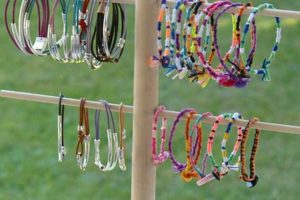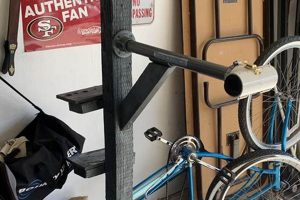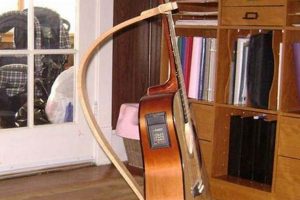A self-constructed support structure designed to hold an aquarium with an approximate capacity of 75 US gallons defines a specific category within home aquarium projects. Such structures are typically built from readily available materials like lumber or metal and are intended to provide a stable and level base for the aquarium, distributing the significant weight evenly. For instance, a wooden frame assembled with screws and sealed for moisture protection exemplifies this type of project.
Constructing a personalized support system offers several advantages, including cost savings compared to commercially produced stands. It also allows for customization to match existing decor or to incorporate specific features, such as storage compartments for aquarium supplies. Historically, hobbyists often resorted to self-built solutions due to limited commercial availability or a desire for greater control over the aesthetic and functional design.
The subsequent discussion will detail the key considerations for creating a robust and aesthetically pleasing support structure. This includes material selection, structural design principles, build techniques, and essential safety precautions. Proper execution ensures the longevity and safety of both the aquarium and its inhabitants.
Construction Advice
Considerations during the design and construction phase are crucial for ensuring the structural integrity and longevity of the completed support.
Tip 1: Precise Measurement and Planning: Accurate measurements of the aquarium’s base are essential before commencing construction. A detailed plan, including dimensions, material list, and joinery methods, prevents errors and material waste.
Tip 2: Material Selection Based on Load: Opt for lumber with sufficient load-bearing capacity, such as kiln-dried pine or hardwood. Steel framing offers an alternative with higher strength-to-weight ratios but requires welding skills.
Tip 3: Robust Joint Construction: Employ strong joinery techniques like screws, bolts, or mortise-and-tenon joints. Wood glue, when used in conjunction with mechanical fasteners, enhances joint strength and stability.
Tip 4: Leveling the Structure: Implement adjustable feet or shims to ensure the support is perfectly level. An unlevel base can induce stress on the aquarium glass, increasing the risk of failure.
Tip 5: Moisture Protection: Apply a waterproof sealant or paint to all wood surfaces, particularly the interior, to prevent water damage from spills or condensation. This measure extends the lifespan of the structure.
Tip 6: Reinforcement for Weight Distribution: Install a solid top surface of plywood or a similar material to evenly distribute the aquarium’s weight across the frame. Avoid relying solely on the frame’s perimeter supports.
Tip 7: Consider Access and Ventilation: Design the structure to allow easy access for maintenance tasks, such as water changes and filter replacement. Include ventilation openings to prevent moisture buildup within the stand’s enclosure.
Adhering to these guidelines ensures the creation of a reliable and safe support, contributing to the long-term stability and health of the aquarium ecosystem.
The final section will delve into the aesthetic finishing and integration of the constructed support into the surrounding environment.
1. Load-bearing capacity
Load-bearing capacity represents a fundamental engineering principle that directly governs the safety and stability of a self-constructed aquarium support. For a 75-gallon aquarium, with its substantial water volume and the added weight of substrate, decorations, and the glass itself, accurately calculating and ensuring adequate support is paramount.
- Material Strength and Span
The intrinsic strength of the chosen building material, such as wood or steel, dictates the maximum weight it can bear over a given span without deformation or failure. For example, a softwood like pine requires thicker dimensions and/or shorter spans compared to hardwood or steel to support the same load. Incorrect material selection or inadequate dimensioning directly compromises the integrity of the support.
- Joint Strength and Construction
The method of joining structural elements significantly influences the overall load-bearing capacity. Weak joints, whether due to insufficient fasteners, inadequate adhesive, or poor design, become points of failure under stress. A properly constructed joint distributes weight effectively, minimizing stress concentrations and maximizing the support’s overall strength. Techniques like mortise and tenon, reinforced with appropriate adhesives and fasteners, contribute to a robust structure.
- Weight Distribution and Support Points
The manner in which the aquarium’s weight is distributed across the support structure is critical. Concentrated loads at specific points can overwhelm localized areas, leading to structural compromise. Even distribution, achieved through a solid top surface and strategically placed vertical supports, ensures that the load is shared across the entire structure, mitigating stress on any single component. Furthermore, it’s necessary to consider the weight of items placed within the stand itself like filters or CO2 tanks.
- Safety Factor and Margin of Error
A prudent design incorporates a safety factor, meaning that the support is engineered to withstand significantly more weight than the calculated load of the filled aquarium. This buffer accounts for unforeseen stresses, variations in material strength, and potential imperfections in construction. A generally accepted safety factor would be to allow for 2x the amount of weight that the aquarium can hold. Neglecting this margin of error increases the risk of catastrophic failure, potentially resulting in water damage and injury.
The relationship between load-bearing capacity and the successful implementation of a self-assembled aquarium support is undeniable. Precise calculations, informed material selection, and sound construction techniques are essential to ensure the long-term stability and safety of the entire aquarium system. Neglecting these factors can lead to disastrous consequences, underscoring the importance of a rigorous and informed approach to design and construction.
2. Structural Stability
Structural stability is a paramount attribute of any self-constructed support intended to house a 75-gallon aquarium. The direct correlation between stability and the safe operation of the aquarium is irrefutable; a compromise in the former invariably leads to a potential failure of the latter. The weight exerted by a filled 75-gallon aquarium, often exceeding 600 pounds, necessitates a rigid and unwavering foundation. Deviations from a stable structure can induce undue stress on the aquarium’s glass panels and silicone seals, ultimately culminating in cracks, leaks, or catastrophic collapse.
Several factors contribute to the overall structural stability of an aquarium stand. The choice of materials, for example, is a primary determinant. While wood remains a common option, the selection of wood species, its thickness, and treatment influence its ability to withstand prolonged stress and moisture exposure. Inadequate dimensions or the use of unsuitable materials, such as low-grade lumber, compromises the stand’s ability to bear the load consistently. Furthermore, the methods employed to join structural components play a critical role. Weak or improperly executed joinery creates points of vulnerability, prone to failure under sustained pressure. Techniques like mortise and tenon or reinforced screw joints are preferred for their superior strength and resistance to shear forces. Another aspect is the need for cross bracing to prevent racking.
The practical significance of understanding the connection between structural stability and aquarium support lies in the prevention of potential hazards. A stable base protects not only the aquarium and its inhabitants but also the surrounding environment from water damage and potential injury. By adhering to sound engineering principles, meticulous construction techniques, and appropriate material selection, it is possible to ensure a safe and durable support system, mitigating the risks associated with unstable structures. Attention to these factors becomes even more critical as the size and weight of the aquarium increase, underscoring the importance of structural stability in any self-built aquarium project.
3. Material Selection
Material selection represents a pivotal stage in the construction of a support intended for a 75-gallon aquarium. The chosen materials directly impact the structure’s load-bearing capacity, longevity, resistance to environmental factors, and overall aesthetic appeal. Prudent material selection ensures the safety and stability of the aquarium setup, while inappropriate choices can lead to structural failure and potential hazards.
- Wood Species and Grades
Various wood species exhibit differing strengths and resistances to moisture. Hardwoods, such as oak or maple, offer superior load-bearing capacity and durability compared to softwoods like pine or fir. However, hardwoods tend to be more expensive and difficult to work with. Lumber grades also play a crucial role; select grades with minimal knots and imperfections provide greater structural integrity. Consideration of these factors allows for a balanced approach, optimizing cost-effectiveness and structural reliability in the support.
- Metal Framing
Steel offers an alternative to wood, providing exceptional strength and resistance to deflection. Steel frames can be constructed using welding or bolted connections, offering design flexibility. However, steel is susceptible to corrosion and requires protective coatings to prevent rust formation. Metal can be used in combination with wood, offering a unique look for the build.
- Fasteners and Adhesives
The type and quality of fasteners and adhesives used to join structural components significantly influence the overall strength and stability of the stand. Screws, bolts, and wood glue are commonly employed, each offering specific advantages depending on the application. Corrosion-resistant fasteners are recommended to prevent degradation in humid environments. High-quality wood glue enhances joint strength and prevents loosening over time.
- Protective Coatings and Sealants
Applying protective coatings and sealants is essential to mitigate the effects of moisture exposure, which can lead to wood rot, metal corrosion, and structural weakening. Waterproof paints, varnishes, and sealants create a barrier against water penetration, extending the lifespan of the stand. The choice of coating should be compatible with the chosen building materials and applied according to manufacturer’s instructions to ensure optimal protection.
In summary, the careful consideration of material attributes, including strength, durability, and resistance to environmental factors, forms the cornerstone of a successful construction. Combining the right materials with expert craftmanship will make it an affordable and sustainable material selection for your aquarium. A judicious approach to material selection, balancing cost, performance, and aesthetic considerations, ensures the creation of a robust and visually appealing support for the 75-gallon aquarium.
4. Level Surface
The concept of a “Level Surface” bears a direct and critical relationship to the construction and function of a “diy aquarium stand for 75 gallon.” The stability of an aquarium, particularly one of this size, hinges upon the even distribution of weight across its entire base. An unlevel surface introduces uneven weight distribution, creating stress concentrations at certain points on the glass panels and silicone seals. These concentrated stresses, over time, can lead to cracking, leaking, or catastrophic failure of the aquarium. Therefore, achieving a perfectly level surface is not merely a cosmetic consideration but an essential safety measure.
The establishment of a level surface necessitates careful attention to detail during the stand’s construction. This begins with selecting level ground for the stand’s placement and ensuring the stand’s frame is square and true. Discrepancies can be addressed through shimming, adjustable leveling feet, or by planing down high spots on the stand’s base. Measurement tools, such as spirit levels or laser levels, are invaluable in this process. For example, consider a scenario where a stand, despite being constructed from sturdy materials, is placed on an uneven floor. The resulting tilt of the aquarium can place undue pressure on the lower front corner, potentially causing a crack over several months. Conversely, a stand meticulously leveled using shims eliminates this stress, ensuring the aquarium’s integrity.
The practical significance of understanding and implementing a level surface extends beyond preventing structural failure. It contributes to the long-term health and stability of the aquarium ecosystem. Undue stress on the tank structure can affect the livestock. The effort invested in creating a level foundation translates directly into increased safety, extended aquarium lifespan, and reduced risk of costly damage or catastrophic events. The principles are straightforward, and the tools are readily available, making a level surface an attainable and vital aspect of any self-constructed aquarium support.
5. Moisture Resistance
Moisture resistance is a critical design consideration for any structure intended to support a 75-gallon aquarium. The inherent proximity to water, coupled with potential spills, condensation, and humidity, creates an environment conducive to material degradation. Failure to adequately address moisture resistance compromises the structural integrity and lifespan of the support.
- Material Selection and Water Absorption
The inherent properties of materials, particularly wood, dictate their susceptibility to water absorption. Porous materials like untreated wood readily absorb moisture, leading to swelling, warping, and ultimately, structural weakening. For instance, untreated pine, a common building material, absorbs water at a higher rate than hardwoods like oak. Selecting moisture-resistant materials or properly treating vulnerable materials mitigates these risks.
- Protective Coatings and Barriers
The application of protective coatings and barriers serves as a primary defense against moisture penetration. Waterproof paints, varnishes, and sealants create a physical barrier, preventing water from reaching the underlying material. For example, applying multiple coats of marine-grade varnish to a wooden stand effectively seals the wood pores, minimizing water absorption. The integrity of these coatings must be maintained to ensure continued protection.
- Ventilation and Airflow
Adequate ventilation and airflow around the support structure help to dissipate moisture and prevent condensation buildup. Enclosed spaces within the stand can trap humidity, creating an environment favorable to mold growth and material degradation. Incorporating ventilation openings or strategically positioning the stand to promote airflow reduces moisture accumulation. For example, leaving space between the stand and the wall allows for air circulation, preventing moisture from becoming trapped.
- Joint Sealing and Waterproofing
The joints and seams within the support structure are particularly vulnerable to moisture penetration. Properly sealing these areas with waterproof caulk or sealant prevents water from seeping into the interior, protecting the underlying materials. For example, sealing the joints between the base and the upright supports with silicone caulk creates a watertight barrier, preventing water damage from spills or condensation.
Addressing moisture resistance through these multifaceted approaches is essential for creating a durable and long-lasting support. The success of a “diy aquarium stand for 75 gallon” hinges on its ability to withstand the rigors of a moisture-rich environment, safeguarding the aquarium and its inhabitants while preventing costly repairs or replacements.
6. Accessibility
Accessibility, within the context of a self-constructed support for a 75-gallon aquarium, refers to the ease with which the aquarist can perform necessary maintenance tasks, access equipment, and interact with the aquarium environment. The design of the stand directly influences the ability to carry out routine procedures such as water changes, filter maintenance, equipment adjustments, and livestock observation. An inadequately designed structure can impede these essential activities, leading to neglect, increased stress on aquatic life, and potential equipment malfunctions.
The integration of accessibility considerations into the design phase is crucial. Factors such as adequate interior space for equipment, readily removable panels or doors for equipment access, and sufficient clearance around the aquarium for cleaning and observation contribute to a user-friendly setup. For example, a stand with limited access may necessitate the dismantling of equipment or the awkward maneuvering of buckets during water changes, increasing the risk of spills and equipment damage. Conversely, a well-designed stand provides ample space and clear access, streamlining maintenance tasks and reducing the likelihood of errors. A door to access the sump pump filter is very important. For optimal maintenance, the access to change any equipment can be done smoothly and in an easy-to-reach manner.
In conclusion, incorporating accessibility into the design of a self-made aquarium support is a practical imperative. By prioritizing ease of maintenance and equipment access, the aquarist promotes a healthier and more sustainable aquarium environment, reducing the burden associated with routine tasks. While aesthetic considerations are important, they should not compromise the functionality and accessibility of the support structure, ensuring the long-term well-being of the aquarium ecosystem and ease of enjoyment for the aquarist.
7. Aesthetic Design
Aesthetic design represents a critical element in the construction of a support structure for a 75-gallon aquarium, extending beyond mere functionality to encompass the visual integration of the aquarium into its surrounding environment. While structural integrity and practicality are paramount, the aesthetic qualities of the support contribute significantly to the overall appeal of the aquarium setup. An aesthetically pleasing stand enhances the viewing experience and complements the interior decor of the space.
- Material Selection and Finish
The choice of materials and their finish directly influences the visual character of the stand. Opting for hardwoods with natural grain patterns, staining wood to match existing furniture, or employing sleek metal finishes can elevate the aesthetic appeal. For example, a stand crafted from dark-stained oak complements a traditional decor, while a minimalist metal frame aligns with a contemporary style. The selected finish should be durable and resistant to moisture damage, preserving the aesthetic qualities over time.
- Form and Proportion
The overall shape, size, and proportions of the stand should harmonize with the dimensions of the aquarium and the surrounding space. A stand that is too bulky or disproportionate can overwhelm the room, while a stand that is too small may appear visually unbalanced. Careful consideration of these factors ensures a visually pleasing and harmonious integration of the aquarium into its environment. Clean lines, geometric shapes, and balanced proportions contribute to a sense of visual order and sophistication.
- Integration of Storage and Functionality
Aesthetic design can be seamlessly integrated with functional considerations, such as storage compartments for aquarium supplies or integrated lighting systems. Incorporating hidden storage compartments maintains a clean and uncluttered appearance, while strategically placed lighting enhances the visual appeal of the aquarium and its inhabitants. Combining form and function in this manner maximizes the utility and aesthetic value of the stand.
- Color Palette and Textural Elements
The selection of colors and textures plays a significant role in the overall aesthetic impact of the stand. A cohesive color palette, complementing the aquarium’s inhabitants and the surrounding decor, creates a sense of visual harmony. Incorporating textural elements, such as textured wood finishes or metal accents, adds depth and visual interest. A thoughtful combination of colors and textures elevates the aesthetic appeal of the stand, creating a visually captivating focal point.
In summary, aesthetic design is an integral component of a well-executed, self-built aquarium support. By carefully considering material selection, form, functionality, and the integration of color and texture, one can create a visually appealing structure that enhances the viewing experience, complements the surrounding environment, and contributes to the overall aesthetic value of the aquarium setup. The consideration of both the functionality and the visual appeal will enhance the overall value of the aquarium project.
Frequently Asked Questions
The following addresses common inquiries regarding the design, construction, and maintenance of a self-built aquarium support intended for a 75-gallon tank.
Question 1: Is it safe to construct an aquarium stand independently, or should a commercially produced stand be favored?
Construction of an aquarium stand independently is permissible, provided sound engineering principles and construction techniques are strictly adhered to. Commercial stands offer convenience and often possess a warranty; however, self-built structures allow for customization and cost savings, contingent upon responsible execution.
Question 2: What are the minimum material requirements for a stand designed to support a 75-gallon aquarium?
Minimum material requirements depend on the chosen building material. For wood construction, kiln-dried pine or hardwood with a thickness of at least 2×4 inches is recommended for framing members. Steel framing should be of appropriate gauge and design to withstand the load. Consult structural engineering guidelines for specific calculations based on the chosen material.
Question 3: How is a level surface ensured during the construction of an aquarium stand?
Achieving a level surface requires the use of measurement tools, such as spirit levels or laser levels. Adjustments can be made using shims or adjustable leveling feet. It is imperative to verify the levelness of the stand both during and after construction.
Question 4: What measures should be taken to protect an aquarium stand from moisture damage?
Protecting against moisture damage involves applying waterproof coatings, such as marine-grade varnish or epoxy resin, to all exposed surfaces. Sealing joints with waterproof caulk prevents water penetration. Adequate ventilation within the stand’s enclosure helps to dissipate moisture and prevent condensation.
Question 5: How can accessibility for maintenance be incorporated into the design of an aquarium stand?
Accessibility is enhanced by incorporating features such as removable panels or doors to allow access to equipment such as filters and pumps. Sufficient clearance around the aquarium facilitates cleaning and maintenance tasks. Strategic placement of access points streamlines routine procedures.
Question 6: What are the potential consequences of neglecting structural integrity during the construction of an aquarium stand?
Neglecting structural integrity can lead to catastrophic failure of the stand, resulting in water damage, potential injury, and loss of aquatic life. It is imperative to prioritize sound engineering principles and construction techniques to ensure the long-term stability and safety of the aquarium system.
Proper planning and execution are paramount in the construction of a safe and functional aquarium support. Consulting with experienced individuals or structural engineers is advisable when uncertainties arise.
The subsequent section will address advanced design considerations and aesthetic enhancements for self-built aquarium supports.
DIY Aquarium Stand for 75 Gallon
The preceding discussion has explored the essential considerations for constructing a secure and aesthetically pleasing structure. Factors such as load-bearing capacity, structural stability, material selection, surface levelness, moisture resistance, accessibility, and aesthetic design have been delineated as critical elements in the successful execution of such a project. The interrelation of these elements dictates the overall performance and longevity of the self-built support.
The construction of a stable and safe support demands diligence, informed decision-making, and adherence to established engineering principles. The aquarium’s success rests upon a reliable foundation, thus encouraging hobbyists to approach the project with seriousness and a commitment to quality. The rewards of a well-executed support extend beyond mere functionality, culminating in an enhanced aquatic display and an environment safe for both inhabitants and the surrounding space.







